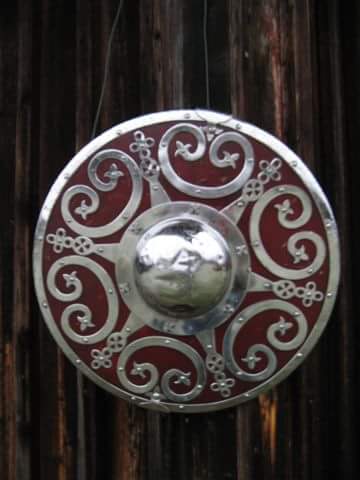Not having my hand on Scott & Martin's 1978-translation from Latin, I'm starting with Forester's from 1905. I'm not sure if it is based on the National Library of Ireland, MS 700 or other extant manuscripts.
| Quote: |
| chapter XXI: "[...] sailed into the Liffy with sixty ships full of Norwegians and men of the isles [...] Landing from their ships, in all haste, they sat down before the east gate of the city, prepared to assault it. [...] and were all warriors, armed in the Danish fashion, some having long breastplates, and other shirts of mail; their shields were round, and coloured red, and were bound about with iron. They were iron-hearted as well as iron-armed men." |
The text is slightly different in Furniwall's Middle English edition based on the early 15th century MS. Trin. Coll., Dublin, E. 2. 31:
| Quote: |
| chapter XIX: "come wyt men of northwey & of þe north ylondes, with ful grett folk, yn furty grett shyppes, [...] Thay wenten out of har̛ shyppes, men well I-wepned, sum with longe swerdes, some with Iren pletes & round sheldes well I-bound about with Iren, swerdes & speres & axys ynowe, & comen̛ well ordeynly for̛ to assaylle the toun on the eest half. " |
and in the early 15th century MS. Rawl. B. 490, Bodl. Libr.:
| Quote: |
| Chapter XIX "[...] come wyth men of North-Wey and of the North ylondys, wyth many pepil, in fourty grete shippys, and londyd in the hauyn of Amlyffy, [...]] Thay wentyn out of har shippis, men wel wepenyd, Some with longe Swerdys, Some with Iryñ Platys and roune sheldys, wel bound aboute with Iryñ, Swerdys and Speres and axes ynow, and comyn wel ordeynly forto assayle the toun on the Eeste halue." |
Blair (1959: 37) interpret this as the first reference to plate armour, laminis ferreis arte consutis, i.e. lamellar, scale or some kind of coat of plates, with Dan Howard leaning towards scale. Direct translation is "iron plates skillfully sewn together", or more genrally "artfully made plates of iron". The distinction is lost in the two Middle English versions, citing only iren plates.
More interesting for my part, but less discussed, is the reference to round shields bound about with iron. How common is the reference to their colour red in the latin manuscripts?
And why on earth does not Forester have any reference to sword, spear or axe like the Middle English translations?
Are these differences between the Latin and Middle English versions only, or can they be explained by differences between Latin versions themselves?
[Ed: Adding text from the Nat. Lib. of Ireland, MS 700, in 1832 said to be from "a very fine MS, of the time of John, in the possesion of Sir Thomas Phillipps." See also the 1603 edition.
| Quote: |
| "[...] cum Norwagiensibus & Insulanis iu sexaginta naubius vrbem expugnaturus, Auenliphense littus obtinuit. A nauibus igitur certatim erumpentes, [...] viri belhcosi Danico more, vndique ferro vestiti, alii loricis longis, alii laminis ferreis arte consutis, clypeis quoque rotundis et rubris, cirvulariter ferro munitis, homines tam animis ferrei quàm armis, ordinatis turmis, ad portam orientalem muros invadunt." |
